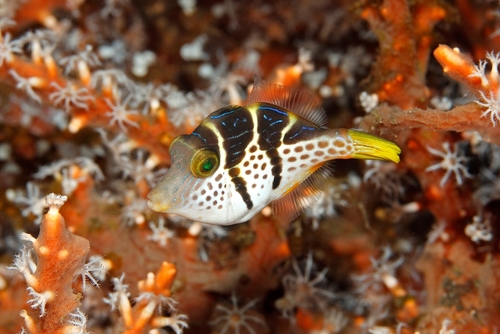Valentini puffers are some of the funniest and prettiest puffers to enjoy seeing in your aquarium. Despite their attitude, it can be fun to find tank mates to shake up the visual interest of the tank. Let’s look at the best Valentini Puffer tank mates!
The best Valentini Puffer tank mates are fish that can handle the semi-aggressive temperament of the Valentini Puffer while also experiencing a healthy life in the same water parameters. They are also roughly the same size as Valentini Puffers and eat slightly different diets or at different times than the Valentini Puffer.
In this article we’ll examine the best tank mates for Valentini Puffers. We’ll go over what’s best for fish owners to know about their pet’s needs, and we’ll take a look at what makes each of the tank mates for Valentini Puffers so compatible. Let’s get started!
Contents
Valentini Puffer Tank Mates – What You Need to Know
Find out what’s best to understand about your Valentini Puffer and its needs in the categories below.

Temperament
Valentini Puffers are generally semi-aggressive when it comes to temperament. This means that if a fish they think they can handle swims into their space, they are likely to behave threateningly. The key to avoiding stressed-out fish and a riotous tank is managing the intimidation of a Valentini puffer.
Valentini puffers need to be around fish that are large and peaceful, or of a similar size and temperament. This will discourage them from starting trouble that they are not sure they can finish victoriously!
Size
Valentini puffers only grow to be about 4 inches long. Though they are not necessarily large fish, they are big enough in attitude and stature to cause trouble when they feel threatened or antsy. The key to maintaining peace in a tank with a Valentini puffer is to make sure they are with fish that are not too much smaller than themselves.
If a Valentini puffer doesn’t think it can successfully bully smaller fish, it may be able to coexist peacefully with other tank mates.
Competition
Competition with tank mates has mostly to do with what foods are offered and whether or not fish have to fight to get to eat first. Valentini puffer fish tend to eat meaty foods. They enjoy hard pelted shrimp, squid, clams, and krill.
Valentini puffers’ diet is the one thing that is easy to maintain when it comes to tank mates. Valentini puffers only need to eat every other day. Simply make sure tank mates eat in a different zone, at a different time, or even different foods than the Valentini puffer entirely to avoid the consequences of competition in feeding.
Parameters & Tank Setup
Valentini puffers need a tank size of at least 20 gallons. Without this much room, their slightly-more aggressive side can show up in nasty ways. They also survive best in a temperature range of 72 to 78 degrees Fahrenheit.
It is a good idea to purchase plenty of rock and obstacles in a community tank that has Valentini puffers. This keeps their eyeline broken up and contributes to the overall peace in the aquarium.
15 Best Valentini Tank Mates
- Blue Tang
- Tomini Tang
- Flame Angelfish
- Tomato Clownfish
- Copperband Butterflyfish
- Lawnmower Blenny
- Convict Tang
- Damselfish
- Pygmy Angelfish
Let’s look at each of our potential Valentini Puffer tank mates in more detail!
You will also like these other top posts in this category:
1. Blue Tang
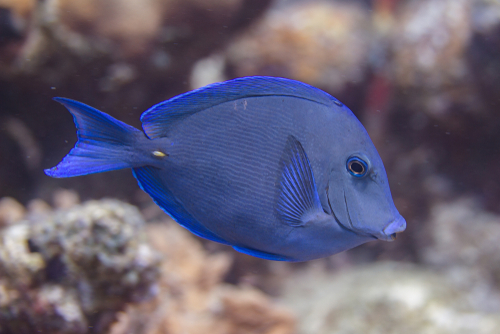
- Scientific Name: Acanthurus coeruleus
- Adult Size: 12 inches
- Compatible With: Valentini Puffer
- Care Level: Medium Difficulty
- Origin: Indo-Pacific
Blue Tangs should be on the favorite list of most people after they featured prominently in Hollywood animation! These fish are a beautiful, eye-catching blue offset by sporty black and yellow markings. They are almost flat in body shape, but are speedy and very “aerodynamic” in the water, making them fun to watch.
Blue Tangs are rather large, but they are unlikely to be picked on by the smaller Valentini Puffers. They are semi-aggressive, themselves, so they shouldn’t be kept with any significantly smaller fish. They can be competitive, but this competition is mostly aimed at others of their own kind in a community tank.
Pros of keeping with Valentini Puffer:
- Too large for fighting
- No food competition
Cons of keeping with Valentini Puffer :
- None!
2. Tomini Tang
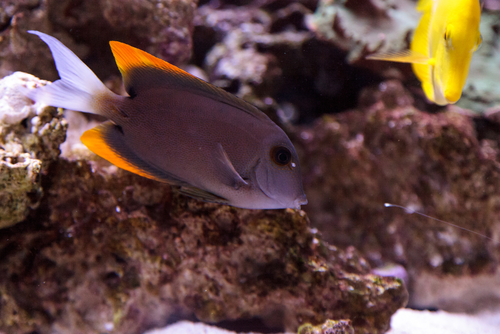
- Scientific Name: Ctenochaetus tominiensis
- Adult Size: 6 inches
- Compatible With: Valentini Puffer
- Care Level: Easy
- Origin: Indonesia
Tomini Tangs go by other names, such as the Tomini Surgeonfish, but are famous for being easy to take care of and easy to match with tank mates. They are not as aggressive compared to others in the tang species. That said, they do have a small chance of getting nippy with other fish.
This actually means that the gray-and-yellow tang will get along well with the Valentini Puffer. They are just similar enough in size without being over-eager for a fight to hang out without ruining the peace of the tank!
Pros of keeping with Valentini Puffer:
- Little aggression
- Too big to fight
- No food competition
Cons of keeping with Valentini Puffer :
- None
3. Flame Angelfish
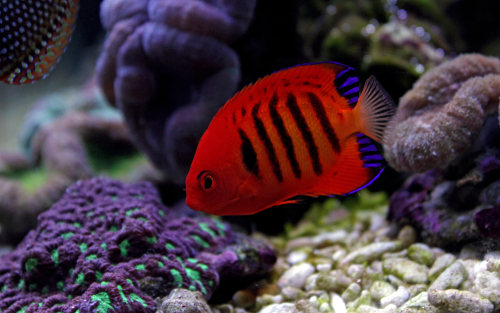
- Scientific Name: Centropyge loriculus
- Adult Size: 4 inches
- Compatible With: Valentini Puffer
- Care Level: Medium Difficulty
- Origin: Hawaii, Pacific Ocean
The flame angelfish is another slightly aggressive fish that can hold it’s own around a Valentini Puffer. It is shaped largely like the head of an arrow with distinctly soft eyes and lips like most angelfish species.
It is also set apart by the flame color that gives it it’s name, offset by blue rimming the fins and black, grill-like stripes. The Flame Angelfish should pose very little threat to the Valentini Puffer’s food sources or territory.
Pros of keeping with Valentini Puffer:
- Too big to fight
- Little aggression
- No food competition
Cons of keeping with Valentini Puffer :
- None
4. Tomato Clownfish
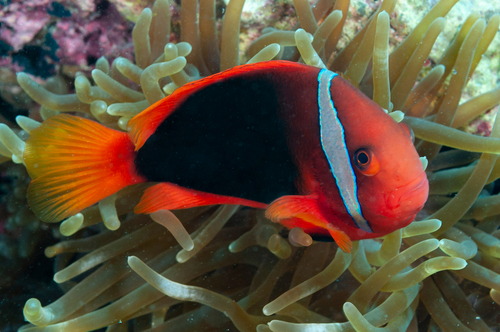
- Scientific Name: A. frenatus
- Adult Size: 5 inches
- Compatible With: Valentini Puffer
- Care Level: Medium Difficulty
- Origin: Japan, Indonesia
This fish is named for its clown-like coloration. It is typically a burnt orange in color. Unlike the more movie-famous clownfish, the tomato clownfish variety usually only has one striking white stripe separating the head from the rest of the more muted-colored body.
The tomato clownfish is another semi-aggressive fish. As long as there are plenty of obstacles like rock formations to give this fish a sense of its own space, it will pose no threat to the Valentini Puffer’s peace of mind!
Pros of keeping with Valentini Puffer:
- Little Aggression
- Too big to fight
- No food competition
Cons of keeping with Valentini Puffer :
- None
5. Copperband Butterflyfish
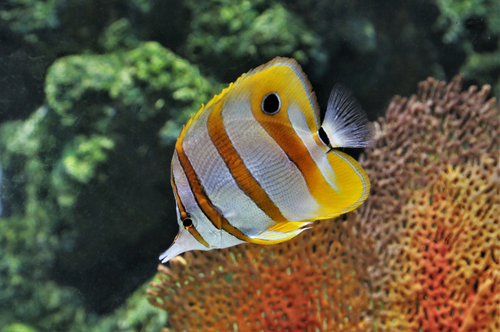
- Scientific Name: Chelmon rostratus
- Adult Size: 8 inches
- Compatible With: Valentini Puffer
- Care Level: Difficult
- Origin: Papua New Guinea
Although it is a beautiful addition to any aquarium, the Copperband Butterflyfish is sometimes hard to care for. It is sometimes picky about eating and likes to eat only when the water conditions are just right.
As picky as this fish is, it is beautiful to look at. It is usually a white undertoned by silver in color. It has yellow stripes, and a striking black spot near it’s tail. In shape, it is a distinct square with a needle-long mouth.
Pros of keeping with Valentini Puffer:
- No aggression
- Too big to fight
- No food competition
Cons of keeping with Valentini Puffer :
- Can be difficult to please at feeding time
6. Lawnmower Blenny
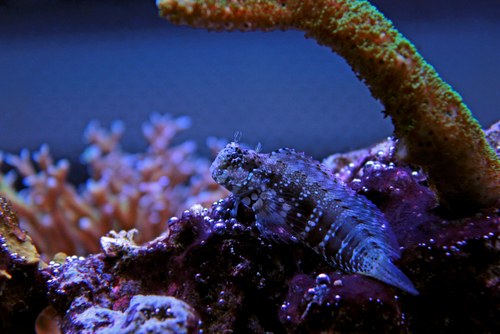
- Scientific Name: Salarias fasciatus
- Adult Size: 5 inches
- Compatible With: Valentini Puffer
- Care Level: Easy
- Origin: Red Sea, Pacific Ocean, Indian Ocean
If you want a laugh or just a shake-up in the visuals of your aquarium, try the Lawnmower Blenny. This fish is very endearing to look at; it’s body is long and it’s eyes are round and bulbous. They look a little bit like someone drew a fish very poorly!
Still, there is something cute about the lawnmower blenny. These fish do like to stay on the bottom of the tank, but they are no strangers to territory fights. As long as they are kept in a tank with plenty of room and enough obstacles to stay away from aggressive fish, they should be fine.
Pros of keeping with Valentini Puffer:
- Too big to fight
- Bottom feeder
Cons of keeping with Valentini Puffer :
- Can be territorial
7. Convict Tang
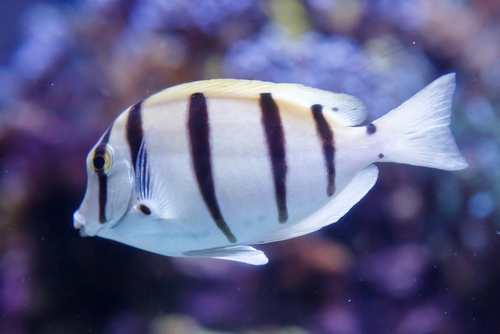
- Scientific Name: Acanthurus triostegus
- Adult Size: 8 inches
- Compatible With: Valentini Puffer
- Care Level: Medium Difficulty
- Origin: Indian Ocean, South, North, Eastern Pacific
The convict tang is named after its fun coloration. It is mostly white with thin black stripes, like cartoon prisoners! The convict tang also has prominent lips and transparent fins.
Convict tangs are just as semi-aggressive as the other tangs and the valentini puffer. They don’t compete with the valentini puffer for food, though, as they swim around all levels of the tank.
Pros of keeping with Valentini Puffer:
- Little Aggression
- Too large to fight
- No food competition
Cons of keeping with Valentini Puffer :
- None
8. Damselfish
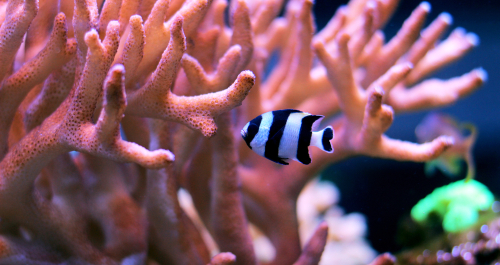
- Scientific Name: Stegastes leucorus
- Adult Size: 6 inches
- Compatible With: Valentini Puffer
- Care Level: Easy
- Origin: Mexico, Pacific Ocean
Damselfish come in a wide range of species and color. Regardless of which kind of damselfish you get, you can usually rest assured that they will make acceptable tank mates to valentini puffers.
That said, damselfish can all be aggressive. As long as you have one of the smaller varieties, or enough obstacles in the tank, you can be sure it will coexist well with valentini puffer Fish.
Pros of keeping with Valentini Puffer:
- Can stand up for itself
- No food competition
- Many varieties
Cons of keeping with Valentini Puffer :
- None
9. Pygmy Angelfish
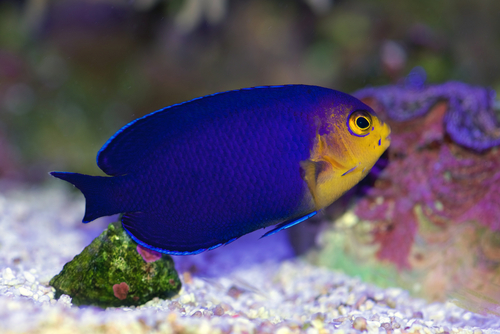
- Scientific Name: Centropyge argiare
- Adult Size: 3 inches
- Compatible With: Valentini Puffer
- Care Level: Easy
- Origin: Atlantic
Pygmy angelfish are named for their smaller size out of all the angelfish. However, they are aggressive in nature and have no problems defending themselves when they feel threatened. This makes them more than suitable as tank mates for valentini puffers.
They are generally round and dark in color, ranging from deep blue to a burnt orange with prominent lips.
Pros of keeping with Valentini Puffer:
- No food competition
- Can stand up for itself
Cons of keeping with Valentini Puffer :
- Can be aggressive with other fish.
In Conclusion
To sum it all up, the best valentini puffer tank mates are those which can handle the puffer’s semi-aggressive attitude, either by being big enough or strong-willed enough to hold their own. They should also have the same water needs, but different food needs. Some of these include Tangs and even the Damselfish. With tank mates like these, you’ll have a vibrant aquarium!

JJ has had a passion for learning about aquatic life since age 5. As an adult, he made his passion a career as a certified aquaculture dealer and aquarium content creator.


